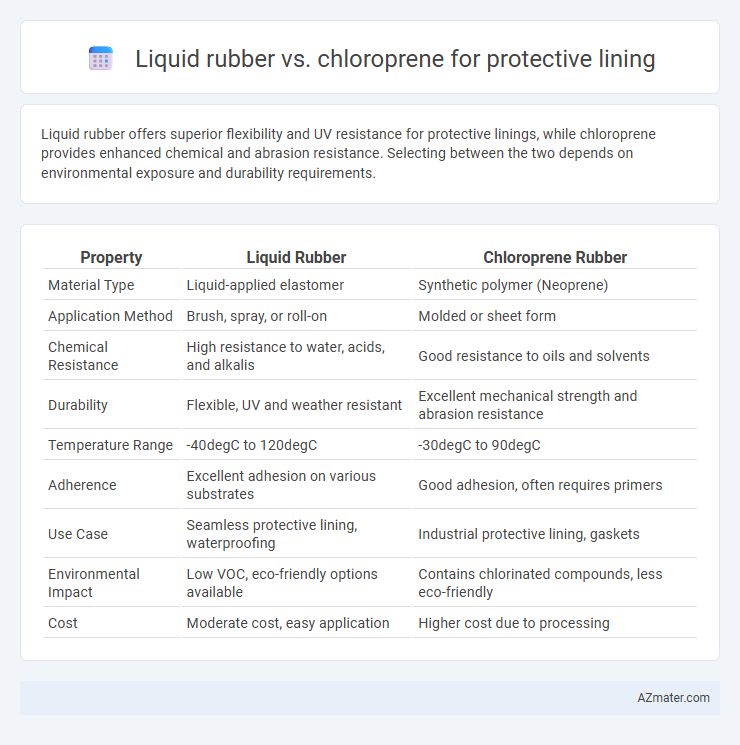Liquid rubber offers superior flexibility and UV resistance for protective linings, while chloroprene provides enhanced chemical and abrasion resistance. Selecting between the two depends on environmental exposure and durability requirements.
Table of Comparison
| Property | Liquid Rubber | Chloroprene Rubber |
|---|---|---|
| Material Type | Liquid-applied elastomer | Synthetic polymer (Neoprene) |
| Application Method | Brush, spray, or roll-on | Molded or sheet form |
| Chemical Resistance | High resistance to water, acids, and alkalis | Good resistance to oils and solvents |
| Durability | Flexible, UV and weather resistant | Excellent mechanical strength and abrasion resistance |
| Temperature Range | -40degC to 120degC | -30degC to 90degC |
| Adherence | Excellent adhesion on various substrates | Good adhesion, often requires primers |
| Use Case | Seamless protective lining, waterproofing | Industrial protective lining, gaskets |
| Environmental Impact | Low VOC, eco-friendly options available | Contains chlorinated compounds, less eco-friendly |
| Cost | Moderate cost, easy application | Higher cost due to processing |
Introduction to Protective Lining Materials
Protective lining materials play a crucial role in safeguarding surfaces from corrosion, abrasion, and chemical damage. Liquid rubber offers flexibility, seamless application, and excellent resistance to water and a wide range of chemicals, making it ideal for waterproofing and sealing. Chloroprene, known for its strong chemical resistance, durability, and thermal stability, is widely used in industrial protective linings where exposure to harsh chemicals and extreme conditions occur.
Overview of Liquid Rubber
Liquid rubber is a versatile, eco-friendly protective lining known for its excellent flexibility, waterproofing, and resistance to chemicals and UV exposure. It forms a seamless, durable coating ideal for corrosion protection in various industrial and marine applications. Unlike chloroprene, liquid rubber offers easier application through brushing or spraying, creating a flexible barrier that adapts to surface movements without cracking.
Overview of Chloroprene
Chloroprene, a synthetic rubber commonly known as Neoprene, offers excellent chemical resistance, flexibility, and durability, making it ideal for protective lining applications. Its superior resistance to oils, solvents, ozone, and weathering ensures long-lasting performance in harsh environments. Chloroprene's versatility and strong adhesion properties allow it to effectively protect surfaces in industrial, marine, and automotive settings.
Key Properties Comparison: Liquid Rubber vs Chloroprene
Liquid Rubber exhibits exceptional flexibility, UV resistance, and waterproofing, making it ideal for protective linings exposed to outdoor elements and dynamic surfaces. Chloroprene, known for its superior chemical resistance, durability, and temperature stability, performs well in harsh industrial environments requiring robust abrasion and solvent protection. Choosing between Liquid Rubber and Chloroprene depends on specific application needs such as flexibility versus chemical resistance, with Liquid Rubber favored for flexibility and Chloroprene preferred for toughness and chemical durability.
Chemical Resistance and Durability
Liquid rubber offers superior chemical resistance against a wide range of acids, alkalis, and solvents, making it highly effective for protective lining in harsh environments. Chloroprene, known for its inherent durability and resistance to oils, ozone, and weathering, provides long-lasting protection but may degrade faster than liquid rubber when exposed to aggressive chemicals. Selecting between liquid rubber and chloroprene depends on the specific chemical exposure and durability requirements of the application.
Flexibility and Application Methods
Liquid rubber offers superior flexibility, enabling it to stretch without cracking, making it ideal for complex shapes and surfaces in protective lining applications. Chloroprene, known for its durability and resistance to chemicals, requires more precise application methods, often involving solvents or specialized adhesives. Liquid rubber can be applied using brushes, rollers, or spray equipment, allowing versatile and efficient coverage compared to the more labor-intensive processes needed for chloroprene linings.
Cost-Effectiveness Analysis
Liquid rubber offers superior cost-effectiveness for protective lining due to its lower initial application costs and reduced maintenance expenses compared to chloroprene. Chloroprene, while durable and chemical-resistant, tends to incur higher material and labor costs during installation and requires more frequent repairs. Overall, liquid rubber provides a more economical solution for long-term protective lining projects by minimizing total cost of ownership.
Environmental Impact and Safety
Liquid rubber offers superior environmental benefits compared to chloroprene, as it is typically water-based, non-toxic, and free from harmful VOCs, reducing air pollution and health hazards during application. Chloroprene, also known as neoprene, involves chlorinated compounds that can release hazardous emissions and pose greater risks to both applicators and the surrounding environment. Selecting liquid rubber for protective lining ensures enhanced safety protocols and aligns with sustainable construction practices by minimizing chemical exposure and ecological footprint.
Typical Industry Applications
Liquid rubber and chloroprene are widely used for protective lining in industries such as chemical processing, marine, and construction. Liquid rubber offers excellent adhesion and flexibility, making it ideal for lining tanks, pipelines, and containment areas exposed to harsh chemicals and weathering. Chloroprene, known for its superior resistance to oils, solvents, and abrasion, is often preferred in automotive, oil and gas, and industrial equipment linings where durability and chemical resistance are critical.
Choosing the Right Protective Lining Material
Liquid rubber offers superior flexibility and seamless application, making it ideal for irregular surfaces and complex shapes in protective lining. Chloroprene provides excellent chemical resistance, durability, and weathering performance, suitable for harsh industrial environments requiring robust protection. Selecting the right material depends on application-specific factors like exposure to chemicals, temperature fluctuations, and substrate compatibility to ensure long-lasting protection.

Infographic: Liquid rubber vs Chloroprene for Protective lining
 azmater.com
azmater.com